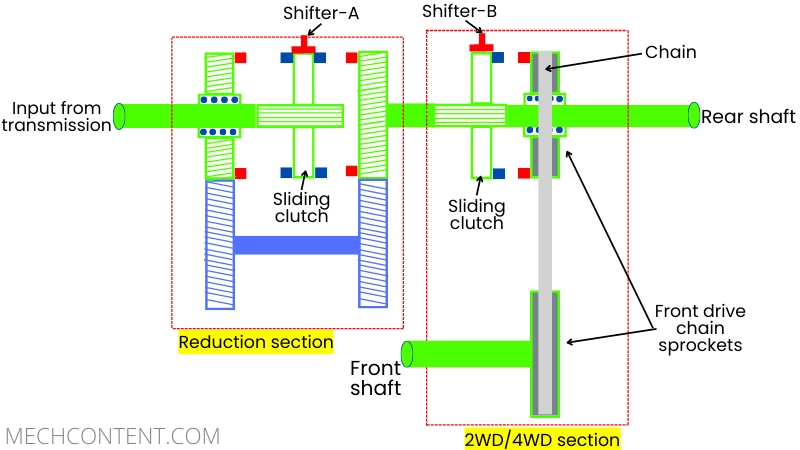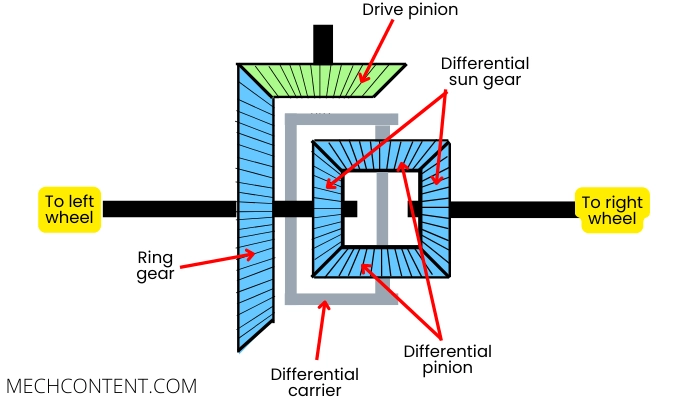The transfer case is key component in four-wheel drive that helps to split power from transmission to the front and rear propeller shafts while a Differential splits power from propeller shaft to two axles of wheels and also helps to drive both wheels (Right & left) at different speeds.

In this article, we’re going to discuss:
- Transfer case:
- Differential:
- Transfer case vs Differential:
- FAQs:
Before moving toward our main discussion, let’s discuss each of them in brief.
Transfer case:

The transfer case is an important component of the four-wheel-drive vehicles that helps to split the power from the transmission output shaft to the front and rear propeller shafts.
The input shaft of the transfer case is connected to the output shaft of the transmission, while in some vehicles the transfer case is mounted directly onto the transmission unit.
Some of the transfer cases also have provision to change the drive mode from 4 wheel drive to the 2 wheel drive and vice versa. The transfer cases also have a speed reduction unit that provides two different speed ratios.
The transfer case indirectly helps to increase traction while moving on slippery roads like icy roads in winter, muddy roads, etc.
Differential:

The differential unit helps to rotate the wheels at different speeds even if they are connected with the same propeller shaft. Therefore while taking a turn, the propeller shaft can run the left and right side wheels at different speeds.
As shown in the above figure, the differential unit consists of a number of bevel gears: Sun gears, differential pinions, Ring gear, Drive pinion, etc.
While moving on the straight road, both the left and right sun gears rotate at the same speed and the differential pinions revolve around them. But in this situation, the differential pinions never revolve around their own axis.
While moving on the curved road, due to the different resistance offered by the road to the left and right side wheels, the differential pinions start to revolve around their own axis. So that the left and right sun gears can revolve at different speeds and the vehicle can take a turn.
Transfer case vs Differential:
| Sr. No | Transfer case | Differential |
|---|---|---|
| 1 | Split the power from the transmission shaft to the front and rear propeller shaft. | Split the power from propeller shaft and helps to drive the left and right side wheels at different speeds. |
| 2 | It is necessary to drive all 4 wheels to increase traction while moving on slippery roads. | While taking a turn or while moving on a bumpy road, the differential unit allows the left and right wheels to rotate at different speeds. |
| 3 | It is used in only four-wheel-drive/All-wheel drive vehicles. | It is essential in both two-wheel drive and four-wheel drive vehicles. |
| 4 | The gears used in the transfer case are spur or helical gears. | It uses bevel gears. |
| 5 | It is connected after the transmission. | It is connected after the final drive. |
| 6 | In the transfer case, the input and output shafts are parallel. | In differential, the input shaft is perpendicular to the output shafts. |
| 7 | Some of the transfer cases also have an inbuilt internal differential that helps to drive the front and rear wheels at different speeds. | It helps to drive the right and left wheels at different speeds. |
| 8 | It requires an oil pump for cooling and lubrication. | It doesn’t require an oil pump. |
| 9 | It requires manual and automatic control to shift the drive mode from 2WD to 4WD and vice versa. | It doesn’t require any manual or automatic control. |
FAQs:
-
What connects the transfer case to the differential?
The transfer case is connected to the differential unit by means of a propeller shaft.
-
Can you drive a car without transfer case and differential?
We can drive the car without a transfer case in 2-wheel-drive mode, but we can’t drive the car without a differential.
Media credits: